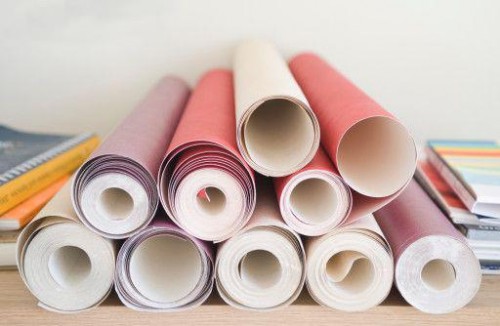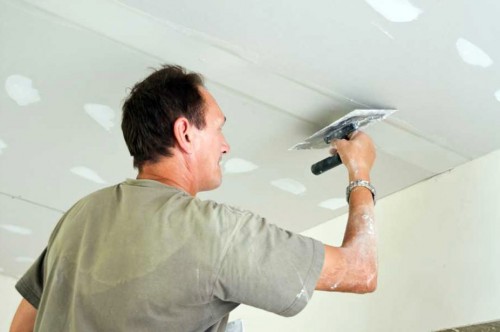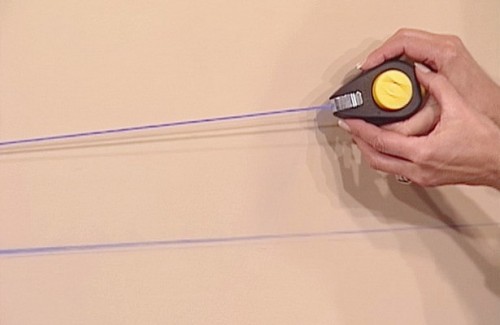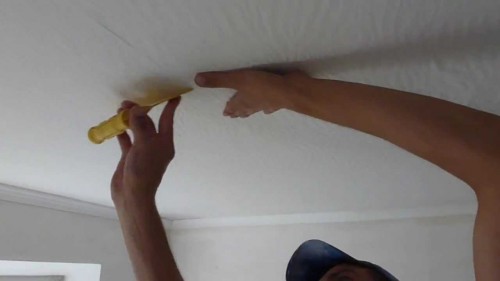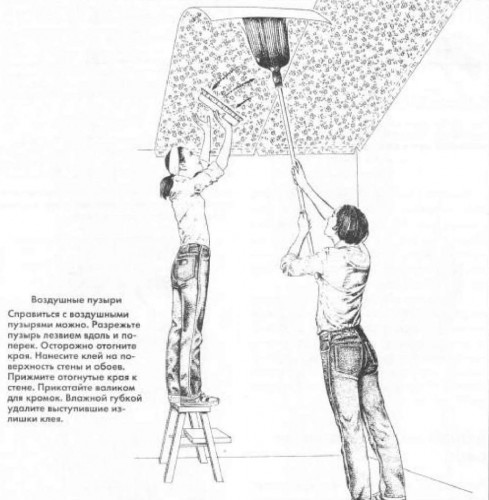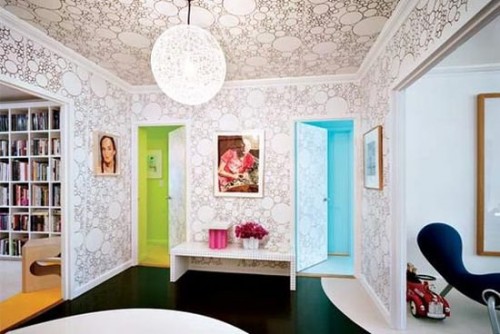
How to glue ceiling wallpaper Wallpaper
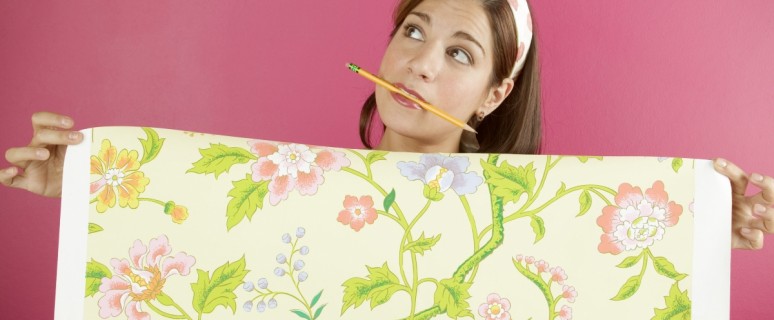
Ceiling wallpapers - a fairly common decor option in modern interiors. The correctly selected texture will allow you to hide some defects and irregularities of the ceiling surface. In addition, wallpapers will help to add colorful to the room, visually make it more spacious. They unobtrusively emphasize the style of the interior or bring new notes to it.
Content
Varieties of ceiling wallpaper
Choosing the ceiling wallpaper, buyers are guided by personal taste and experience, also much depends on the financial capabilities, the planned interior style and the condition of the ceiling. Paper, fabric, synthetic wallpaper - options are quite a lot.
Traditionally, paper ceiling wallpapers are produced in Russia, on sale In stock Extensive selection of similar products. Abroad, such a separate concept as "ceiling wallpaper" does not exist, the wallpaper for painting is successfully used in their quality.
Ceiling wallpapers for painting (on paper and fliseline base, vinyl, as well as fiberglass) allow you to find the perfect color combination for a particular interior.
A wide selection of ceiling wallpapers is available on sale:
- Paper - from conventional wallpapers there are a big density, as well as light tones - to give a greater visual height of the room. In terms of its structure, they are two canvas glued together with embossed, in the presence of a wide selection of all sorts of patterns and textures. Paper wallpapers can not be washed and painted, their service life is no more than 5 years. Over time, such wallpaper is polluted - the dust accumulate, absorb smoke. If you decide to buy paper ceiling wallpapers, then you have the ability to ecoly and access the ceiling finish.
- Ceiling fliesline wallpapers - consist of cellulosic and textile fibers with the addition of the polymer binder component. The use of phlizelin gives a product of texture and decorativeness, due to interesting visual effects, the drawing is characterized by volume. Wallpaper on a flieslinic basis are light and durable, perfectly passed air, do not swell during wetting and do not give shrinkage. Release both building fliesline (to obtain an effect perfectly smooth smooth surface) and textural wallpapers with a painting pattern. They differ significantly higher price compared with paper, service life is up to 15 years.
- Wallpaper from fiberglass is made on special weaving machines from natural raw materials - glass bottles. Thanks to a special chemical processing, these products acquire high density, durability and resistance to various impacts. Such wallpapers are environmentally friendly, not allergenic, do not accumulate the charge of static electricity. A wide selection of color palette is offered, multiple painting (water-based paints or latex) is allowed. Wallpaper from fiberglass are available at a price, and the life of their operation reaches 30 years.
- Vinyl (washable) wallpapers - consist of two layers (the basics - fliseline or paper, as well as the upper layer - PVC). This composition of materials allows you to imitate any texture and get a variety of patterns and reliefs. Vinyl wallpapers do not "breathe" - therefore, to eliminate the appearance of mold and fungi on the walls in their composition include special anti-grapple additives. There are vinyl wallpapers for painting.
How to glue the ceiling wallpaper
Preparation for sticking
When sticking ceiling wallpaper, the following process features should be taken into account:
- if it is necessary to glue the wallpaper on the ceiling and on the walls, then first bother the ceiling;
- it is necessary to plan the lighting - thinking how the wiring will be displayed, outline the location of the lamps. Before the start of the shocking of the wallpaper, the chandelier existing on the ceiling is better to remove;
- it is recommended to place the ceiling wallpaper in the direction of the incident light, i.e. from the window - so that the junctions between the rows be less noticeable;
- it is more convenient to glue such wallpapers together - the second person when sticking can hold the remaining rolled wallpaper strip;
- before starting work, you need to tightly close all windows and doors, turn off the air conditioner (otherwise the drafts will be reduced on all operations - wallpapers can take air bubbles and even fall off in places). Do not forget to de-energize the wiring.
First of all, you need to prepare the ceiling. Ceiling wallpapers possess their relief and do not require a perfectly smooth surface, as they can smooth out small errors. It is necessary to remove all old coatings from the ceiling (wallpaper, paint and blotch), cracks and irregularities to sweep with a putty, and then color the ceiling. To facilitate the removal of old wallpaper, you can use the wet roller. Lime whitewash hot water with a tissue napkin or sponge.
If there are serious defects, finishing works will be required to equalize the ceiling surface - with spatlement or plasterboard panels. Wallpaper sticking must be carried out on a dry, as smooth and clean surface.
There is an opinion that acrylic primer pre-applied to the surface of the ceiling facilitates the process of sticking the ceiling wallpaper, and they quickly and neatly stick. This primer "breathes" (does not produce greenhouse effect) dries over an hour.
Marking ceiling
It is necessary to place the ceiling with parallel lines between the walls (wallpapers are glued in the direction from the window so that the joints are less noticeable). On both sides, a distance equal to the width of the wallpaper roll is noted, minus 2-3 cm on the seams. Next, stretching the lace parallel to the walls, the guide lines are applied. The length of the wallpaper cloths should be equal to the length of the room with the addition of launching on the walls (1.5-2 cm on each side), and also need to take into account the shrinkage after drying the adhesive (usually about 0.5%).
Cooking glue
Browse the instructions that are present on the wallpaper rolls packages. On them the manufacturer indicates which grade glue is suitable for this product. The glue composition depends on the material, density and thickness of the wallpaper. What they are harder, the more thick there should be a solution of glue to secure them on the ceiling. For vinyl wallpapers, a composition containing a fungicide (substance preventing the formation of fungus) is recommended. For paper wallpapers, glue universal or based on corn or maize starch. Mixtures with synthetic resins, waterproof, with increased clutch (for example, dispersion glue - used for vinyl, textile, and fiberglass wallpaper) are used.
Glue in the form of a dry mixture is bred by water according to the instructions and leave half an hour for swelling. It is not necessary to make it too liquid, better in the process of sticking, if necessary, add water. To achieve a qualitative result, it is worth carefully learning instructions for the use of this type of wallpaper and glue. The adhesive solution can be stored for about a week in a closed container, while it will save its properties.
The process of sticking ceiling wallpaper
This process is quite painstaking and requires assistants, but with the right organization of labor, you can try to cope and one.
For blowing ceiling wallpapers, we will need the following tools and materials:
- roulette for ceiling markup;
- acute knife and scissors;
- spatula for removing old paint;
- roller or brush for applying glue;
- own brush or clamping roller;
- rubber shutter for joints;
- large sponge for erasing excess glue, cotton rods;
- stepladder either high table;
- special glue for ceiling wallpaper.
Works on sticking ceiling wallpapers can be divided into the following steps:
- Wallpaper rolls roll out, measure the desired length, if necessary, we adjust the drawing, cut into the same bands with a knife.
- We decorate the wallpaper strip face down on a clean surface of the table or on the floor. With the help of a wide brush, we carefully wrap it with glue, starting from the middle and distributing on the sides, not forgetting about the corners and edges, and leave to be soaked for 5-7 minutes. At this time we apply glue to the ceiling section where we will clipped the wallpaper. It is important to note that if paper or vinyl wallpapers are used - their web needs to be missed, if the wallpaper flieslinic - glue is applied only on the wall and the canvases are located in the junction.
- The cooked strip will be comfortable to fold the "accordion" with folds of a width of about 30 cm, and in the future, in a further fold, glued to the ceiling. You can also hold the free part of the wallpaper with a smooth wand or roller in the width of the strip. We climb with prepared wallpaper on the lap, capturing a bulk brush or clamping roller with you, as well as scissors, a sponge, rag.
- We apply wallpaper strip to the ceiling, from the wall consistently align it by location, smoothing out from the middle to the edges. It is necessary to control the direction according to the applied markup lines. After sticking the entire segment, it is necessary to walk over a brush again to close to the ceiling tightly and remove the remaining air bubbles. Next, it is necessary to cut the edge of the sheets with a knife over the solder. If there is an excess glue - we remove them with a sponge.
- Next, we glue the subsequent web, carefully tracking the direction and alignment of the joints. The seams must be clean and tightly fixed with glue.
Ceiling wallpaper - Photo:
How to glue Ceiling Wallpaper - Video
Ceiling wallpaper - video




